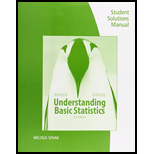
Concept explainers
For Problems 9-17 assume that the distribution of differences d is mound-shaped and symmetric.
Please provide the following information for Problems 9-17.
(a) What is the level of significance? State the null and alternate hypotheses. Will you use a left-tailed, right-tailed, or two-tailed test?
(b) Check Requirements What sampling distribution will you use? What assumptions are you making? Compute the value of the sample test statistic and corresponding t value.
(c) Find (or estimate) the P-value. Sketch the sampling distribution and show the area corresponding to the P-value.
(d) Based on your answers in parts (a) to (c), will you reject or fail to reject the null hypothesis? Are the data statistically significant at level
(e) Interpret your conclusion in the context of the application.
In these problems, assume that the distribution of differences is approximately normal.
Note: For degrees of freedom d.f. not in the Student's t table, use the closest d.f. that is smaller. In some situations, this choice of d.f. may increase the P-value by a small amount and therefore produce a slightly more ‘‘conservative” answer.
Wildlife: Highways The western United States has a number of four-lane interstate highways that cut through long tracts of wilderness. To prevent car accidents with wild animals, the highways are bordered on both sides with 12-foot-high woven wire fences. Although the fences prevent accidents, they also disturb the winter migration pattern of many animals. To compensate for this disturbance, the highways have frequent wilderness underpasses designed for exclusive use by deer. elk. and other animals.
In Colorado, there is a large group of deer that spend their summer months in a region on one side of a highway and survive the winter months in a lower region on the other side. To determine if the highway has disturbed deer migration to the winter feeding area, the following data were gathered on a random sample of 10 wilderness districts in the winter feeding area. Row B represents the average January deer count for a 5-year period before the highway was built, and row A represents the average January deer count for a 5-year period after the highway was built. The highway department claims that the January population has not changed. Test this claim against the claim that the January population has dropped. Use a 5% level of significance.
Units used in the table are hundreds of deer.
| Wilderness District | 1 | 2 | 3 | 4 | 5 | 6 | 7 | 8 | 9 | 10 |
| B: Before highway | 10.3 | 7.2 | 12.9 | 5.8 | 17.4 | 9.9 | 20.5 | 16.2 | 18.9 | 11.6 |
| A: After highway | 9.1 | 8.4 | 10.0 | 4.1 | 4.0 | 7.1 | 15.2 | 8.3 | 12.2 | 7.3 |
Trending nowThis is a popular solution!

Chapter 10 Solutions
Student Solutions Manual for Brase/Brase's Understanding Basic Statistics, 7th
- Show all workarrow_forwardplease find the answers for the yellows boxes using the information and the picture belowarrow_forwardA marketing agency wants to determine whether different advertising platforms generate significantly different levels of customer engagement. The agency measures the average number of daily clicks on ads for three platforms: Social Media, Search Engines, and Email Campaigns. The agency collects data on daily clicks for each platform over a 10-day period and wants to test whether there is a statistically significant difference in the mean number of daily clicks among these platforms. Conduct ANOVA test. You can provide your answer by inserting a text box and the answer must include: also please provide a step by on getting the answers in excel Null hypothesis, Alternative hypothesis, Show answer (output table/summary table), and Conclusion based on the P value.arrow_forward
- A company found that the daily sales revenue of its flagship product follows a normal distribution with a mean of $4500 and a standard deviation of $450. The company defines a "high-sales day" that is, any day with sales exceeding $4800. please provide a step by step on how to get the answers Q: What percentage of days can the company expect to have "high-sales days" or sales greater than $4800? Q: What is the sales revenue threshold for the bottom 10% of days? (please note that 10% refers to the probability/area under bell curve towards the lower tail of bell curve) Provide answers in the yellow cellsarrow_forwardBusiness Discussarrow_forwardThe following data represent total ventilation measured in liters of air per minute per square meter of body area for two independent (and randomly chosen) samples. Analyze these data using the appropriate non-parametric hypothesis testarrow_forward
 College Algebra (MindTap Course List)AlgebraISBN:9781305652231Author:R. David Gustafson, Jeff HughesPublisher:Cengage Learning
College Algebra (MindTap Course List)AlgebraISBN:9781305652231Author:R. David Gustafson, Jeff HughesPublisher:Cengage Learning Glencoe Algebra 1, Student Edition, 9780079039897...AlgebraISBN:9780079039897Author:CarterPublisher:McGraw Hill
Glencoe Algebra 1, Student Edition, 9780079039897...AlgebraISBN:9780079039897Author:CarterPublisher:McGraw Hill

